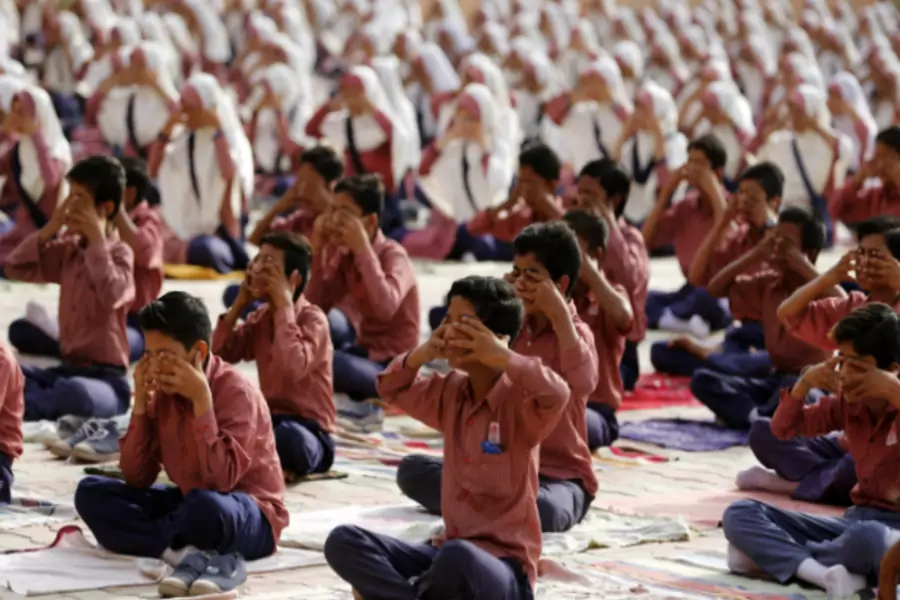Namaste, World! India Amps Up its Yoga Diplomacy

Tuesday, June 21, marks the second year of “International Day of Yoga,” a UN designation enacted in December 2014 through a General Assembly resolution introduced by India. It came about after Prime Minister Narendra Modi’s September 2014 address to the assembly, where he spoke about yoga as a potential solution for many of the world’s challenges, including climate change. Since then, Modi has continued to reference yoga’s benefits in a variety of speeches, including most recently his address to a joint meeting of the United States Congress. While this concern might appear esoteric to outsiders, Modi, and the government he leads, is one hundred percent serious about expanding the framework in which people around the world think of yoga and its role.
When I first heard Modi mention yoga in his 2014 UN speech, it was not yet clear where this proposal would go on the international stage. Domestically, the Modi government clarified early on its desire to elevate yoga within Indian institutions. For example, in late 2014 the government created a new ministry for Indian systems of medicine and yoga (the “AYUSH” ministry, once a department housed under the Ministry of Health) to better showcase and regulate these disciplines. Some universities in India will begin offering stand-alone yoga departments.
More on:
But internationally, it was uncertain what the Indian government would do with yoga on the world stage, or what it would mean beyond the obvious photo-ops. Given that last year’s inaugural observance of International Day of Yoga was a bit of an experiment, this year provides a signal about how the Indian government plans to institutionalize the use of yoga in its public diplomacy—the central purpose of the day.
Over the past two weeks, Indian diplomatic missions, the Ministry of External Affairs, and the prime minister of India himself have ramped up their social media diplomacy on yoga in the run up to June 21, with everything from photographs of yoga practitioners around the world:
From Colombia to New Zealand!
Love for #yoga on display as crowds throng for #IDY2016 events#YogaDay pic.twitter.com/ISic3nq7Hz
— Vikas Swarup (@MEAIndia) June 20, 2016
More on:
To a new commemorative stamp collection:
These are different stamps depicting the different Asanas of Surya Namaskar. #IDY2016 pic.twitter.com/t5c2W3jv48
— Narendra Modi (@narendramodi) June 20, 2016
To daily videos demonstrating yoga poses tweeted by the prime minister. Here’s just one:
Makarasana is useful to mitigate back problems & orthopedic ailments. #IDY2016https://t.co/cmdbxhyL3s
— Narendra Modi (@narendramodi) June 18, 2016
On Monday, Prime Minister Narendra Modi released a four-minute video that explains his view of yoga and its role in advancing Indian foreign policy. He reaffirmed his view of yoga’s status as “the invaluable gift of India’s ancient traditions” and went on to describe its benefits to preventive health care and wellness, two fast-growing preoccupations around the world.
Citing adherents from “the Pacific Islands to Port of Spain, from Vladivostock to Vancouver” and other alliterative locations around the world, he spoke of yoga as the “exemplary manifestation of vasudhaiva kutumbakam, ‘the world is one family.’” Vasudhaiva kutumbakam is not any ordinary descriptive phrase; it also serves as an orienting principle for Indian foreign policy. Rooted in a Sanskrit saying, the notion that the “world is one family” both celebrates India’s idea of itself as a unique civilization with much to offer and captures its desire to keeps itself outside of alliance blocs, while maintaining ties with all.
Modi closes his yoga day video speaking directly to his viewers, observing that “all of you are the ambassadors of yoga, taking forward India’s ancient message for the world.” He then thanks the viewers for their “commitment,” and welcomes them as “sisters and brothers of India’s family.”
Here we have as clear a statement as any of the role the Indian government sees for yoga internationally: not just as a cultural feature to be appreciated, like dance, but as an aspect of India’s civilization with an ability to enlist its adherents into extensions of Indian diplomacy itself. For a practice which had found its Indian connection attenuated as it exploded in global popularity, especially in the West, the Modi government’s focus on reclaiming yoga for India’s profile on the world stage marks an interesting new posture. Maybe we can call it Diplosana.
Follow me on Twitter: @AyresAlyssa
 Online Store
Online Store